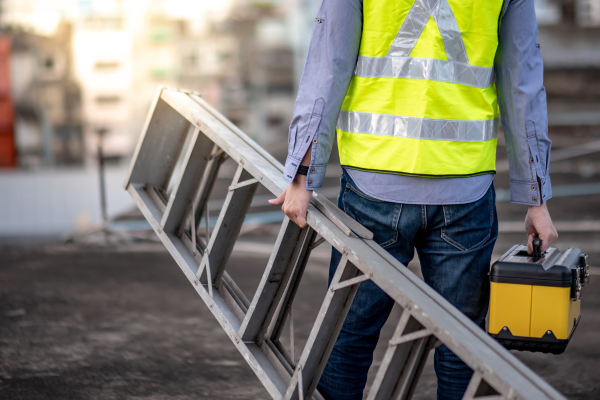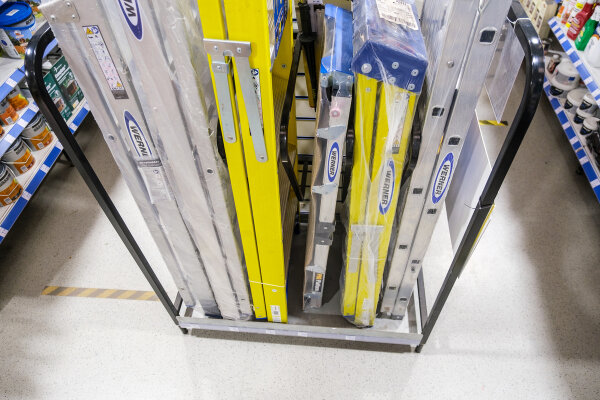Mastering Ladder Safety: A Comprehensive Guide For The Trade

February 22nd, 2024
Today, we're discussing a topic that's
crucial to every tradesperson - ladder safety. Understanding how to safely
utilise a ladder is crucial in ensuring a safe working environment whilst
preventing avoidable accidents. This guide delves into different aspects of
ladder safety from the basics to the regulations and the training necessary to
comply with safety standards. Our aim is to arm you with the knowledge needed
to make informed decisions and prioritise safety on your jobs.
The importance of ladder safety in the trade
Ladder safety is a critical aspect of working at heights within the construction industry. This section will explore the significance of ladder safety, basic principles to adhere to, and debunk some common misconceptions. Every year, numerous accidents on construction sites are linked to improper ladder usage, resulting in severe injuries or even fatalities. By implementing appropriate safety measures, we can significantly lower these risks.
The 3 principles of ladder safety
When it comes to ladder safety, there are a few basic principles to keep in mind. Firstly, choosing the right ladder for the task is vital. Ladders come in various types, sizes, and materials, each designed for specific purposes. Choosing the right ladder ensures stability and minimises the risk of accidents.
Secondly, always inspect the ladder before use. Look for any signs of damage, such as broken rungs or loose fittings, as these could compromise the ladder's stability. Using a damaged ladder can lead to serious accidents.
Finally, ensure proper ladder positioning and setup. The ladder should be placed on a firm and level surface, at the correct angle (usually a 75-degree slope) for stability. Overreaching or standing on the top rungs, which can result in a loss of balance, should be avoided.
Common Misconceptions
Now, let's debunk some common
misconceptions about ladder safety. Many believe that simply leaning a ladder
against a wall provides sufficient stability. However, it's crucial to secure
the ladder properly with braces or tie-offs to prevent it from slipping or
falling.
Another misunderstanding is that ladders are suitable for all tasks. Ladders have weight limits and aren't designed for heavy-duty work or carrying heavy loads. For such tasks, it's important to use alternative equipment, like scaffolding or elevated platforms. Understanding the importance of ladder safety, following basic principles, and dispelling common misconceptions promote a safer working environment. At Brewers, we offer a range of high-quality ladders, platforms and towers designed with safety in mind. Browse our selection to find the right product for you>>
Different types of ladders and using them safely
Using the right ladder for the job can prevent accidents and ensure a successful project completion. There are various types of ladders designed for specific purposes:
- Step Ladders: These self-supporting ladders are perfect for tasks that require both hands, such as painting or changing light bulbs.
- Extension Ladders: Ideal for reaching higher areas, these adjustable ladders are commonly used for exterior construction or maintenance work.
- Platform Step Ladders: These ladders have a platform for added stability and comfort, commonly used for prolonged tasks in warehouses or construction sites.
- Telescopic Ladders: These compact and portable ladders can be extended to various heights, suitable for tasks that require flexibility and easy transportation on construction sites.
No matter the type of ladder, observing safety guidelines is essential to minimise the risk of accidents.
Complying with ladder safety regulations and training in the UK
In the UK, strict regulations are in place surrounding ladder use in the construction industry. These regulations aim to prevent accidents and injuries that can occur due to improper ladder use. According to the Health and Safety Executive (HSE), employers have a legal duty to ensure that work at height is properly planned, organised, and performed by competent individuals. This includes the use of ladders. The Work at Height Regulations 2005 provide specific guidelines for ladder safety on construction sites.
Understanding these regulations and complying with them is crucial for both employers and employees. Failure to do so can result in serious consequences, including legal action and fines. While regulations provide a framework for ladder safety, receiving proper ladder safety training is equally important. Training provides the necessary knowledge of correct ladder use techniques and potential risks.
Regular inspection and maintenance of ladders are also critical to ensure their safety and longevity. Before using a ladder, visually inspect it for signs of damage or wear. Any damaged or faulty ladders should be removed from service promptly.
By adhering to ladder safety regulations,
receiving proper training, and maintaining ladders, we can prevent accidents
and promote a safer working environment in our industry.






